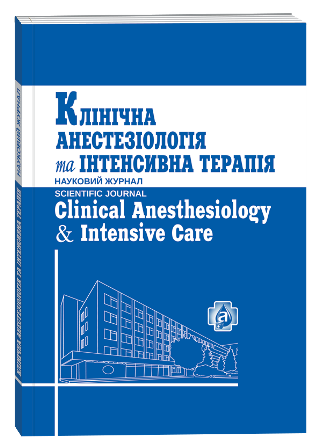GROUNDS FOR ANALGESIA TO PREVENT POSTOPERATIVE HYPERALGESIA IN CHILDREN ACCORDING TO THE MORPHOLOGICAL STUDY OF SKIN IN THE WOUND
Keywords:
analgesia, hyperalgesia, skin biopsyAbstract
The aim of our study was to determine the morphological changes in the area of skin in the wound and the development of hyperalgesia after applying various schemes of anesthesia at the early post-operating period in children with cancer. Matherials and methods. The study carried out in 47 children (13.4±2.4 years) operated for abdominal tumors (24 children, 51%), retroperitoneal tumors (23 children, 49%). Depending on the method of anesthesia, patients were divided into four groups: 1 group (12 children) — analgesia with continuous intravenous infusion of fentanyl, 2 group (12 children) — combined analgesia with bupivacaine TAP — block; 3 group (13 children) — combined spiral epidural analgesia, and 4 group (12 children) — analgesia with continuous intravenous infusion of ketamine. Results. Using high fentanyl doses (10–20 mcg/kg·hr) by continuous infusion method for analgesia in the early postoperative period in children operated on for tumors of abdominal cavity, can result into opioid-induced hyperalgesia, which is followed by skin morphological changes around the postoperative wound with the development of necrosis in its center with expressed perifocal reactive changes of severe inflammation and significant violations of microcirculation. With the formation on the 14th day of the formation of small nerve fibers. In its turn by using of TAP-block and combined spiral-epidural analgesia method small perineural edema was determined, fragmentation of nerve fibers was not determined. Using ketamine infusion results into negligible perineural edema and reduction of postoperative hyperalgesia. Conclusions. Was found that the use of high doses of fentanyl (10–20 mg/ (kgЧh)) by continuous infusion in the early postoperative period in children operated for tumors of the abdominal cavity can lead to opioids induced hyperalgesia, accompanied by morphological changes in the skin around the wound.
References
Региональная анестезия в педиатрии / В. Л. Айзенберг, Г. Э. Ульрих, Л. Е. Цыпин, Д. В. Заболотский. – СПб. : Синтез Бук, 2012. – 304 с.
Кучин Ю. Л. Стрес-індукована гіпералгезія у пацієнтів з множинною травмою / Ю. Л. Кучин // Біль, знеболювання та інтенсивна терапія. – 2013. – № 2 (Д). – С. 262–266.
Лесной И. И. Предупреждение развития хронического послеоперационного синдрома у хирургических больных / И. И. Лесной, В. И. Черний, К. Ю. Белка // Український журнал екстремальної медицини ім. Г. О. Можаєва. – 2012. – Т. 13, № 3. – С. 26–32.
Потапов А. Л. Обезболивание после объемных открытых абдоминальных операций — опиаты или эпидуральная аналгезия? / А. Л. Потапов, Ю. Ю. Кобеляцкий // Біль, знеболювання і інтенсивна терапія. – 2011. – № 4. – С. 39–42.
Wilder-Smith O. H. Postoperative hyperalgesia: its clinical importance and relevance / O. H. Wilder-Smith, L. Arendt-Nielsen // Anesthesiology. – 2006. – № 104 (3). – P. 601–607.
Lavand’homme P. Intraoperative epidural analgesia combined with ketamine provides effective preventive analgesia in patients undergoing major digestive surgery / P. Lavand’homme, M. De Kock, H. Waterloos // Anesthesiology. – 2005. – № 103 (4). – P. 813–820.
A comprehensive review of opioid-induced hyperalgesia / M. Lee, S. Silverman, H. Hansen [et al.] // Pain Physician. – 2012. – № 14 (2). – P. 145–161.
Celerier E. Opioid-induced hyperalgesia in a murine model of postoperative pain: role of nitric oxide generated from the inducible nitric oxide synthase / E. Celerier, J. R. Gonzalez, R. Maldonado // Anesthesiology. – 2006. – № 104 (3). – P. 546–555.







